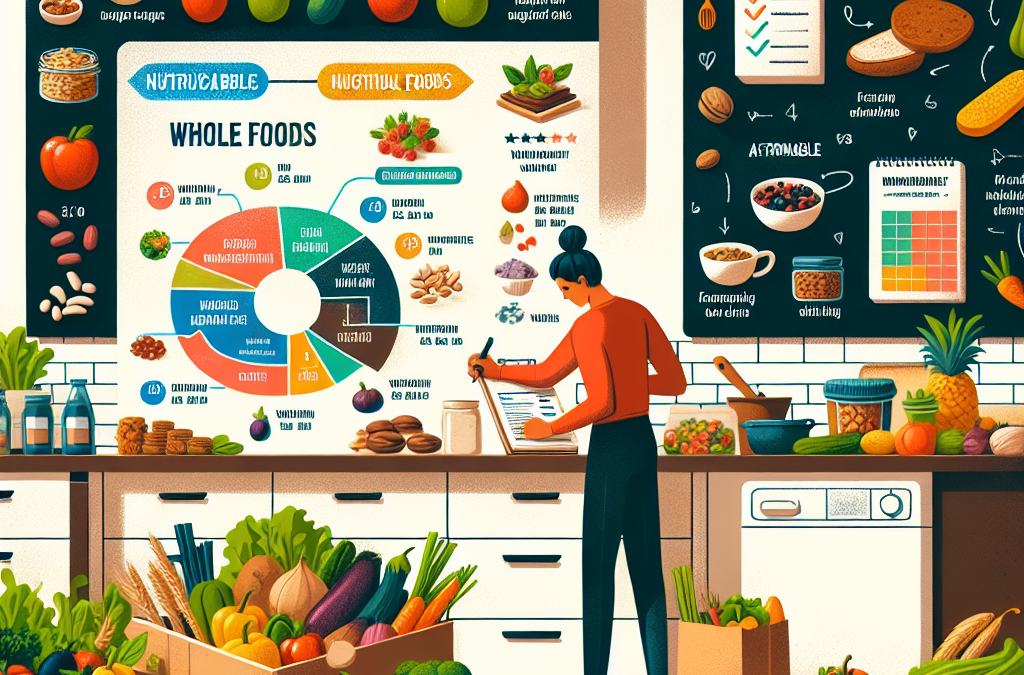Get an Amazing Discount on Best Organic SuperFood Product!
How to Eat Healthy on a Budget with Whole Foods
- Eating Healthy on a Tight Budget
- Shopping Smart at Whole Foods
- Meal Planning for Healthy Eating
- Storing and Preparing Whole Foods
Eating Healthy on a Tight Budget
Understanding the Basics of Healthy Eating
When I first decided to eat healthier, I quickly realized that healthy foods often come with a hefty price tag. However, I discovered that understanding what healthy eating truly means is key to making it affordable. Healthy eating is about balancing nutrients, choosing whole foods, and avoiding processed junk. This doesn’t have to break the bank.
I found that focusing on whole grains, lean proteins, fruits, and vegetables is where it all starts. For example, instead of splurging on organic snacks, I would buy whole grains like oats and brown rice, which are not only filling but super cheap. And while it may feel like an investment, these foods really pack in the nutrition you need.
It’s also essential to regard portion sizes. Sometimes eating less of something that’s more nutritious can actually save you money in the long run. Plus, healthier foods often keep you fuller for longer, so you’re not reaching for additional snacks every half hour.
Making Budget-Friendly Choices
Finding budget-friendly choices doesn’t mean just picking the cheapest options available. I learned that some healthier foods, though slightly higher priced, offer more value in terms of nutrition. When I spot sales on seasonal produce, I stock up and use them in various meals.
Another great tip is to look for store brands or bulk bins. Whole Foods has a great selection of bulk items, and buying in bulk often cuts costs significantly. I’ve saved tons of money by purchasing grains, nuts, and spices in bulk instead of in pre-packaged, single-serving amounts.
Lastly, keeping an eye on local farmers’ markets or co-ops can lead to some fantastic savings. Locally sourced veggies and fruits are often fresher and less expensive than their store counterparts. Trust me, your wallet and taste buds will thank you!
Finding Alternatives to Expensive Foods
There’s no denying that some “health foods” come with astronomical prices, like certain superfoods or specialty items. But what I have learned is that you can find wholesome, budget-friendly alternatives. Instead of kale chips, I make my own roasted kale; you save cash and get a tasty snack to boot.
Another swap I make is between fresh herbs and dried spices. Fresh herbs can be pricey, but dried spices pack a punch in flavor and can be found for a fraction of the cost. Just a little goes a long way, and I can find interesting flavor profiles without draining my wallet.
Lastly, don’t forget about seasonal produce. Buying fruits and veggies that are in season not only tastes better but are usually less expensive. If strawberries are in season, go for it! If not, try frozen berries which maintain their nutritional punch and are often cheaper.
Shopping Smart at Whole Foods
Utilizing Sales and Discounts
I absolutely love shopping at Whole Foods, but I’ve learned to navigate it wisely to avoid those scary bills. The first step is knowing how to find weekly sales and discounts. They often have a “Deals” section where you can spot markdowns on various products, from snacks to shelf-stable goods.
Another great strategy I adopt is signing up for their rewards program. It’s free, and it often gives exclusive discounts. Sometimes I can score fabulous deals, especially on everyday items like pantry staples and cleaning supplies!
I also recommend checking out their organic section. Surprisingly, organic produce can sometimes be cheaper than conventional options, especially during sales. It’s worth the time to scope out the whole layout and see where you can snag a deal.
Making the Most of Your Shopping List
Your shopping list is your best friend, trust me. Before heading out, I plan my meals for the week and only buy what I need. This helps prevent impulse buys and minimizes food waste. I focus on filling my cart with versatile ingredients, like rice, beans, and seasonal veggies that can stretch over multiple meals.
I’ve also found that shopping on a full stomach makes a world of difference in my choices! When I’m hungry, I tend to grab everything in sight. But when I’ve had a decent meal beforehand, I stick to the list and resist temptations.
Don’t forget about the fresh produce isle. I try to select items that can serve double duty—like mushrooms that can work in a stir-fry and on pizzas. Think creatively! This not only keeps my meals interesting but also helps my budget stretch further.
Picking the Right Products
Not all products are created equal, even at Whole Foods. I’ve learned to read the labels and ingredients. Sometimes the store-brand items can be significantly cheaper while offering similar ingredients to more expensive brands.
I also recommend looking for products with fewer additives and preservatives. Whole Foods does a great job at providing high-quality options, so I usually aim for whole food alternatives—like choosing whole-grain pasta, for instance. Better for your health and often about the same price!
On top of that, utilizing the bulk section can save a lot, especially for snacks and pantry staples. I fill my own containers, which not only reduces packaging waste but also lets me buy just what I need—no more, no less!
Meal Planning for Healthy Eating
The Power of Meal Prep
Meal prepping has been a game-changer for me—seriously! Every Sunday, I dedicate a couple of hours to cooking and portioning out meals for the week. Doing this means I can curate my meals to be both healthy and budget-friendly.
I start by choosing a couple of proteins, some grains, and a bunch of veggies. I can whip up a simple stir-fry or a grain bowl, and then portion it into containers for easy access during my busy week. This way, I avoid the temptation of takeout when I’m short on time!
Plus, meal prepping helps cut down on food waste, which is essential when trying to stick to a budget. I use up everything I buy—which feels good on my wallet and conscious!
Creating a Versatile Menu
I’ve learned over time that keeping my menu versatile is key. I build meals that allow for substitutions. For example, if I have quinoa cooked and ready, I can turn it into salads, bowls, or as a side.
I recommend picking a theme for the week, like Mexican or Italian. What I’ve found is I can take similar base ingredients and adjust the spices to create something entirely different. It keeps things fresh and exciting without extra cost!
Using leftovers creatively has also helped me. A roasted chicken one day can be a chicken salad the next. This not only saves money but allows you to get the most bang for your buck.
Sticking to Your Meal Plan
Sticking to a meal plan can be tricky, but I’ve found success with a few simple tricks. Keeping my meal plan visible—like hanging it on the fridge—reminds me of what I’ve got cooked and ready to go.
I also track my pantry to see what I have before making any additional purchases. This way, I avoid buying duplicates and make sure nothing goes to waste.
Keeping things flexible is crucial, too. If I’m not in the mood for what I planned, it’s perfectly fine to swap out a meal or two. The point is to eat healthy and to enjoy it, so staying adaptable keeps it enjoyable!
Storing and Preparing Whole Foods
Best Practices for Storage
Keeping my whole foods fresh is essential for reducing waste and sticking to a budget. I always store fruits and veggies in a way that maximizes their lifespan. For example, I keep berries in the fridge but avoid washing them until I’m ready to eat them.
Using airtight containers has also been a game changer. I repack bulk items to maintain their freshness, like grains and nuts. This little habit has significantly extended shelf life and kept my pantry feeling organized!
I’ve also learned to freeze foods before they spoil. Any leftover veggies, fruits, or even pre-cooked meals can easily be stored in the freezer. This turns what would be waste into something useful later on.
Preparation Techniques for Maximum Flavor
When it comes to actually cooking, I believe in the power of preparation techniques to bring out flavors without complicating things. Roasting veggies is one of my favorites—just drizzle some olive oil and spices and let the oven do the work!
I’ve also started experimenting with various cooking methods. Steaming greens instead of boiling them has kept their vibrant colors and nutrients intact, making my meals not just healthy but visually appealing as well.
Another technique I love is marinating proteins. Using simple ingredients like lemon juice and herbs adds tons of flavor and really elevates my meals. Prepping proteins for grilling or sautéing in advance has made weeknight cooking quick and hassle-free!
Incorporating Variety into Your Meals
Eating healthy doesn’t mean sacrificing fun! I always aim to incorporate a rainbow of fruits and veggies into my meals. This helps maintain interest and excitement in healthy eating.
I also do different cuisines throughout the week, exploring recipes from different cultures. Turns out, cooking internationally increases the variety of whole foods I’m consuming, making my meals much more dynamic.
It’s also important to think about textures. I mix things up with crunchy nuts, chewy grains, and tender veggies. This not only makes eating a more enjoyable experience but keeps me satisfied!
FAQs
1. How can I eat healthily on a strict budget?
Eating healthy on a restricted budget involves meal planning, utilizing sales, and shopping smartly. Focus on whole grains, in-season produce, and buying in bulk to save money while ensuring you eat nutritious foods.
2. What are some smart shopping tips for Whole Foods?
At Whole Foods, look for their sales, use store-brand products, and make use of their rewards program. Create a detailed shopping list centered around versatile ingredients, and don’t forget to check bulk bins for lower prices.
3. How can I reduce food waste while eating healthy?
To cut food waste, meal prep weekly, use leftovers creatively, and store food properly. Freezing leftover ingredients or meals is a great way to keep things fresh until you’re ready to use them.
4. What are some quick meal prep ideas?
Simple meal prep ideas include making grain bowls with versatile ingredients, roasting seasonal vegetables, or preparing proteins in advance. The key is to focus on dishes that can easily transform throughout the week!




